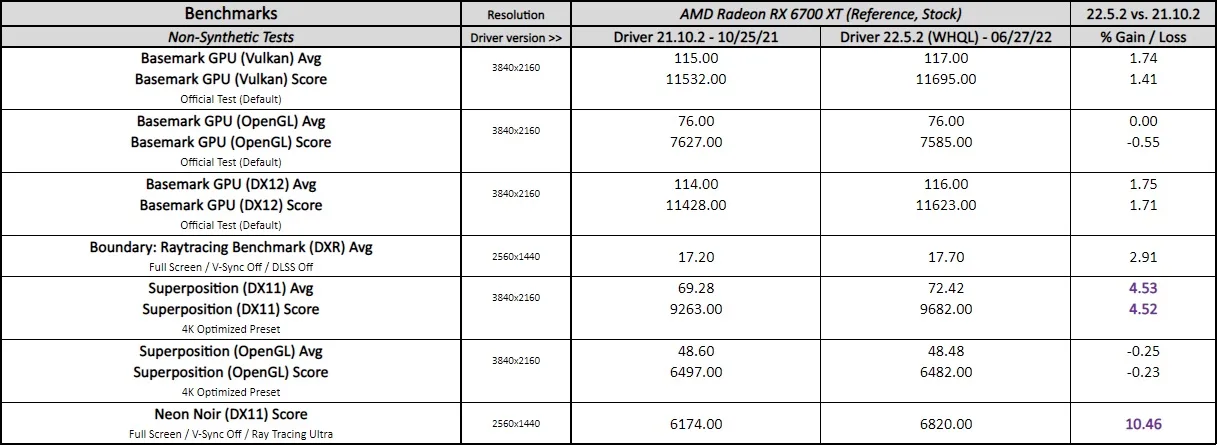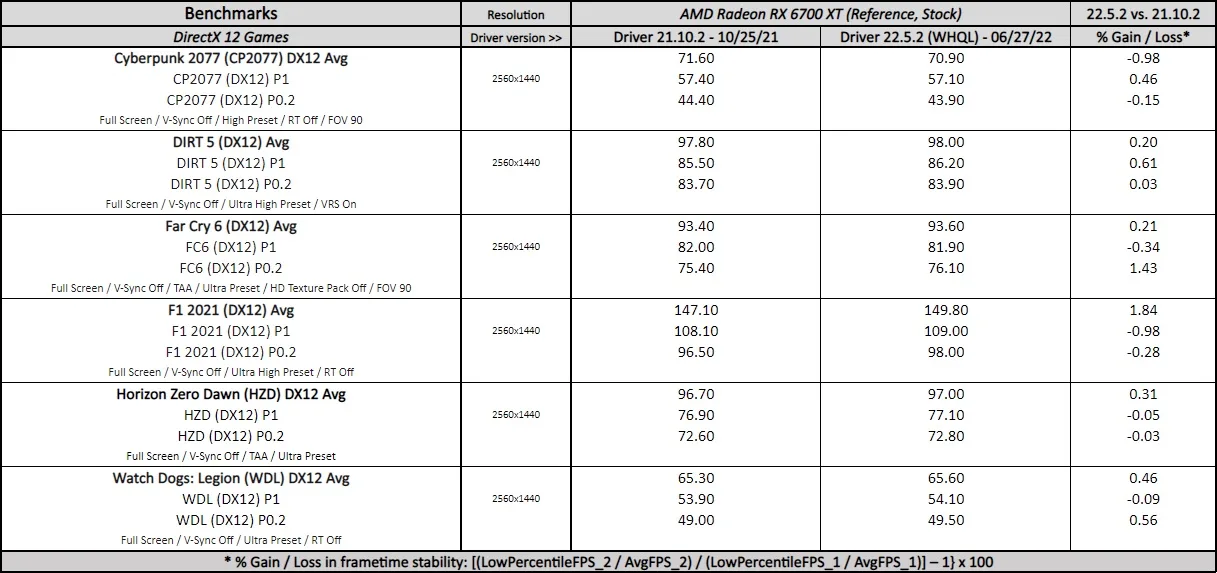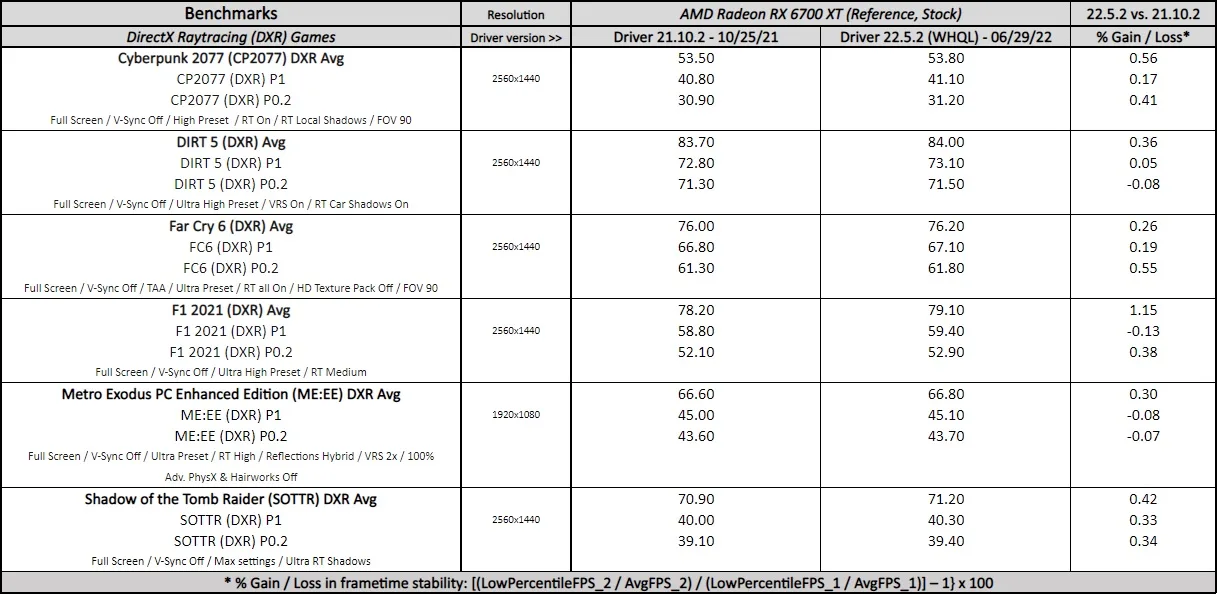Adrenalin 22.6.1 Driver Performance Analysis – 22.6.1 vs 21.10.2 – Fine Wine? – 17 games benchmarked using the RX 6700 XT
This review tests AMD’s fine wine theory by showcasing the latest reference Radeon RX 6700 XT’s Adrenalin driver performance with 17 PC games. We benchmark the WHQL Optional Adrenalin 22.6.1 driver released a few days ago versus our nine-month-old recommended driver 21.10.2. We perform all tests using the same game version and the same OS build.

This time, our testing platform is a recent install of Windows 11 64-bit Pro Edition, an i9-12900K with stock clocks, an ASUS PRIME Z690-P D4 motherboard, and 32GB of T-FORCE XTREEM ARGB WHITE DDR4 3600MHz. The games tested, settings and hardware, are identical except for the drivers we compare.
Benching Methodology
Test Configuration – Hardware
- 12th Gen Intel Core i9-12900K (Hyper-Threading/Turbo boost on; stock settings)
- ASUS PRIME Z690-P D4 motherboard (Intel Z690 chipset, v.1008 BIOS)
- T-FORCE XTREEM ARGB WHITE 32GB DDR4 (2×16GB, dual-channel at 3600 MHz CL14 XMP), supplied by TeamGroup
- AMD Radeon RX 6700 XT (Reference) 12GB, stock clocks, on loan from AMD
- 1 x Samsung 500GB SSD 960 EVO NVMe M.2
- 2 x WD Blue 1TB SATA SSD
- 1 x TeamGroup MP33 M.2 PCIe 1TB SSD
- Corsair RM850x, 850W 80PLUS Gold power supply unit
- ASUS TUF Gaming VG289Q 28? IPS UltraHD (3840×2160) 60Hz 5ms FreeSync Monitor for testing games at 2160p resolution.
- ASUS ROG Swift PG279Q 27? IPS QuadHD (2560 x 1440) 165Hz 4ms G-Sync Monitor for testing games at 1440p resolution.
Test Configuration – Software
- AMD Software Adrenalin 22.6.1 drivers, and 21.10.2 drivers; default AMD Radeon features and settings; AMD FreeSync ‘Disabled’ (when applicable).
- AMD SAM/Resizable BAR On
- V-Sync ‘off, unless application specifies’ in the Software Adrenalin control center; V-Sync off in-game.
- AA and AF as noted in games; all in-game settings are specified.
- Windows 11 64-bit Pro edition, latest updates v21H2; High-performance power plan; Game Mode, Game DVR & Game Bar features off; Control Flow Guard (CFG) off on a per-game basis; Hypervisor and Virtualization-based security are disabled.
- We do not install GIGABYTE and ASUS tools.
- Latest DirectX
- All 17 games are patched to their latest versions at the time of publication.
- 3DMark’s suite and UNIGINE Superposition benchmark, the latest version
- Basemark GPU benchmark, v.1.2.3
- UNIGINE Superposition, v.1.1
- CapFrameX (CX), the latest version
- RivaTuner Statistics Server (RTSS), the latest version
- Display Driver Uninstaller (DDU), the latest version; always uninstall old driver using DDU in safe mode, clean, and restart.
-
ISLC (Purge Standby List) before each benchmark.
Radeon Software Adrenalin Suite-related
- The minimal Radeon Adrenalin Software installation is used.
- We install the display driver.
- We enable the ‘Issue detection’ setting.
Hybrid & Non-Synthetic Tests-related
- Single run per test.
Game Benchmarks-related
- The corresponding built-in or custom benchmark sequence is used.
Frametimes Capture & Analysis tool-related
- We use CapFrameX for capturing and analyzing the relevant performance numbers obtained from each recorded built-in or custom benchmark sequence.
- We always perform consecutive runs until detecting 3 valid runs (no outliers) that we can aggregate using CapFrameX and the following method:
- ‘Aggregate excluding outliers’:
- Outlier metric: Third, P0.2 (0.2% FPS percentile).
- Outlier percentage: 3% (the % the FPS of an entry can differ from the median of all entries before counting as an outlier).
- ‘Aggregate excluding outliers’:
- We compare and evaluate the results and aggregated records in terms of percentages of gain/loss and set the following thresholds to consider a % value as significant (not within the margin of error) for our benchmarking purposes:
- Score/FPS Avg > 3% when valuing hybrid and non-synthetic benchmarks;
- FPS Avg > 3% when evaluating raw performance;
- P1/P0.2 > 3% when evaluating frame time consistency; after applying our custom formula
{[(LowPercentileFPS_2 / AvgFPS_2) / (LowPercentileFPS_1 / AvgFPS_1)] – 1} x 100
Benchmark Suite: 17 PC Games, 4 Hybrid & 4 Non-Synthetic Tests
DX11 Games
- Borderlands 3 (DX11)
- Chernobylite (DX11)
- Days Gone (DX11)
- Deus Ex: Mankind Divided (DX11)
- Far Cry New Dawn (DX11)
- Tom Clancy’s The Division 2 (DX11)
DX12 Games
- Cyberpunk 2077 (DX12)
- DIRT 5 (DX12)
- F1 2021 (DX12)
- Far Cry 6 (DX12)
- Horizon Zero Dawn (DX12)
- Metro Exodus PC Enhanced Edition (DX12)
- Shadow of the Tomb Raider (DX12)
- Watch Dogs: Legion (DX12)
Vulkan Games
- DOOM Eternal (VK)
- Quake 2 RTX (VK; v.1.5.0)
- Wolfenstein Youngblood (VK)
Software Adrenalin Control Center Settings
Here are the global Adrenalin Control Center settings:

All the AMD Radeon Software Adrenalin features and settings are default.
AMD Radeon Software Adrenalin 22.6.1
This latest Radeon Software Adrenalin 22.6.2 Optional (WHQL) driver was released on June 29 primarily for the launch of F1 2022.

The download links for the Adrenalin 22.6.1 Optional drivers can be found starting here. The 22.6.1 release notes can be found here.
Here are the release highlights of Adrenalin v22.6.1 from AMD Radeon’s website:
Support for F1 2022:
-
-
-
- Up to 5% increase in performance in F1 2022 @ 4k Ultra High settings, using AMD Software: Adrenalin Edition 22.6.1 on the Radeon RX 6950 XT, versus the previous software driver version 22.5.2.
- Up to 4% increase in performance in F1 2022 @ 4k Ultra High settings, using AMD Software: Adrenalin Edition 22.6.1 on the Radeon RX 6800 XT, versus the previous software driver version 22.5.2.
- Up to 6% increase in performance in F1 2022 @ 4k Ultra High settings, using AMD Software: Adrenalin Edition 22.6.1 on the Radeon RX 6750 XT, versus the previous software driver version 22.5.2.
-
-
Fixed Issues
-
-
-
- Performance drop may be experienced while playing Fortnite with Multithreaded Rendering and DirectX 11 API on some AMD Graphics Products such as the Radeon RX 6900 XT.
- Stuttering may be experienced while playing Overwatch with some AMD Graphics Products such as the Radeon RX 6700 XT.
- Higher than expected CPU usage when Instant Replay is enabled on some AMD Graphics Products such as the Radeon RX 6900 XT.
- Fan Tuning option may be missing on some AMD Graphics Products such as the Radeon RX 590.
-
-
The Adrenalin 22.6.1 Driver Performance – Summary Charts with 17 Games
Below you can find the summary charts of our representative selection of 17 games plus 4 hybrid and 4 non-synthetic benchmarks. We chart our games’ driver performance progression from version 21.10.2 to 22.6.1 using the reference AMD Radeon RX 6700 XT.
You can see the list of graphics settings on the charts, and we run each built-in or custom game benchmark’s sequence at 2560×1440, except for Far Cry New Dawn, tested at 3840×2160 resolution; and Metro Exodus PC Enhanced Edition (DXR) and Quake 2 RTX (Vulkan Ray Tracing Pipeline) which are tested at 1920×1080 resolution.
Results give average framerates and higher is better. We display the low FPS percentiles (P1 and P0.2) below the corresponding averages. We use CapFrameX to record frametimes over time and to visualize and convert them into their corresponding average FPS and P1 and P0.2 FPS percentiles values.
There are also columns showing percentages of gain/loss in both raw performance (average FPS) and, when applicable, in frametimes consistency or stability between the different driver versions. We applied the following custom formula to calculate the stability gains or losses:
{[(LowPercentileFPS_2 / AvgFPS_2) / (LowPercentileFPS_1 / AvgFPS_1)] – 1} x 100
We mark significant performance changes (higher than 3%) in bold and use purple for the significant improvements or orange font for regressions.
Adrenalin 22.6.1 Driver Performance Charts







Notes on Adrenalin 22.6.1 Driver Performance – 22.6.1 vs. 21.10.2 – Fine Wine?
From the charts, although we see no significant differences in graphics performance between drivers for the hybrid tests, we see significant performance improvements in Superposition (DX11) and Neon Noir (DX11) non-synthetic tests.
For the game benchmarks, although many games show no significant differences when we upgrade to the 22.6.1 drivers from 21.10.2, we saw notable performance improvements in most DX11 games such as Borderlands 3 (DX11), Days Gone (DX11), Deus Ex Mankind Divided (DX11), and Far Cry New Dawn (DX11), as well as in Doom Eternal (Vulkan & Vulkan Ray Pipeline) and Quake 2 RTX (Vulkan Ray Query).
The only negative outlier with driver 22.6.1 is The Division 2 (DX11), which showed a noticeable regression in terms of frame time consistency resulting in micro-stuttering during gameplay.
Disclaimer
Please be aware that the following results, notes, and the corresponding driver recommendation are valid for similar RDNA 2.0 gaming rigs on Windows 11 v21H2. Its representativeness, applicability, and usefulness on different AMD Radeon micro-architectures, testing benches, and Microsoft Windows versions may vary.
Conclusion
So, do Radeon cards’ performance get better with age as newer drivers bring more performance? Or asked another way, does the performance comparison of 22.6.1 vs. 21.10.2 drivers act as a good example to support the Fine Wine theory?
Based on our previous results and findings, we answer yes to this question, and we recommend RDNA 2.0 gamers update to the latest Adrenalin 22.6.1 driver. Its raw performance and smoothness or frametimes consistency level are overall better in most DX11 games and some Vulkan games than with our last recommended driver.
There are relevant qualitative reasons that also make it advisable to upgrade to version 22.6.1. These reasons include a higher level of security and driver bug fixes, optimizations for the latest games, and support for the latest AMD Radeon technologies.
Let’s Play!
***
Rodrigo González (aka “RodroG”) is an enthusiast gamer and tech reviewer interested especially in shooter games, open-world role-playing games, and software and hardware benchmarking. He is the author of the NVIDIA WHQL Driver Performance Benchmarks Series and founder and moderator of the r/allbenchmarks community on Reddit.
*The featured image is from AMD.